Future Systems FGT100 VPN GATEWAY User Manual FCC040401
Future Systems, Inc. VPN GATEWAY FCC040401
Contents
- 1. Users Manual 1
- 2. Users Manual 2
Users Manual 2

4-1
C
Ch
ha
ap
pt
te
er
r
4
4
O
Op
pe
er
ra
at
ti
in
ng
g
S
Se
ec
cu
uw
wa
ay
yG
Ga
at
te
e
1
10
00
0
『Chapter4. Operating SecuwayGate 100 』covers various
system maintenance features, including how to check the LED
displays, how to replace the whole or a part of SecuwayGate
100, and how to change IP addresses in SecuwayCenter 2000,
and how to change security policies in SecuwayGate 100.
The LED displays of SecuwayGate 100 help you identify the
current status of SecuwayGate 100 with regard to connection,
operation, and hardware failure. Depending on the status of the
device you identified, you may need to take appropriate actions,
such as editing the properties of the SecuwayGate 100 or
replacing the device with a new one.
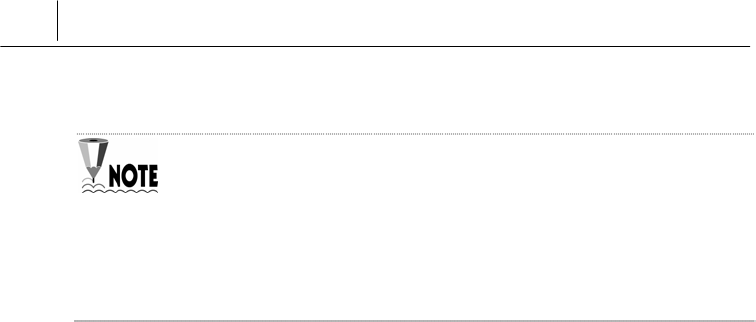
4-2 Chapter 4
Operating SecuwayGate 2000
The SecuwayGate 100 log is stored in RAM and SecuwayCenter
2000 log is stored in the Center Log MSSQL database. The
SecuwayGate 100 sends its log in response to regular requests by
SecuwayCenter 2000, ever minute. SecuwayCenter 2000
stores the received SecuwayGate 100 logs in the Gate Log MSSQL
database. There is separation between the Center Logs and the Gate Logs

4-3
4.1 LED Status
When SecuwayGate 100 is in a normal state, the Power
LED and Secure LED are ‘ON’. The Net LED, which
represents the transmission state of the rear-panel network
interface, blinks in a normal state.
z
When
SecuwayGate 100
is a in normal state
LED Display Initial State (Factory-Default)
Power LED ON
Alarm LED ON
Secure LED OFF
It represents the initial factory default for
installing SecuwayGate 100.
LED Display Normal State (After Setup)
Power LED ON
Alarm LED OFF
Secure LED ON
It indicates that the initial setup has been
completed with the Smart card issued from
SecuwayCenter 2000 and
SecuwayCenter 2000 has been found.
The normal state of each LED is as shown in
the left pane.
The Net LED on the front panel keeps blinking according to the
transmission state of the network interface port located on the rear side of
the device. If the port is not physically connected to a line or a device, the
Net LED is ‘OFF’, not blinking.
z
When an error occurred in SecuwayGate 100
LED Error & Troubleshooting
Secure LED
blinks
Indicates that the SecuwayGate 100 failed to
receive a set of security settings from
SecuwayCenter 2000 when it attempted to
initiate a communication with Secuway Center
2000 as soon as it completed the configuration
setup. Check the cable connection to the Net port of
SecuwayGate 100 and the service status of
SecuwayCenter 2000.

4-4 Chapter 4
Operating SecuwayGate 2000
LED Error & Troubleshooting
Secure LED is
OFF
Indicates that no security policy is applied to
SecuwayGate 100. If the Secure LED is turned
off during the normal service mode, it implies that
SecuwayGate 100 is incapable of acting in
accordance with the security policies set in
SecuwayCenter 2000. It means you need to
create a new Smart card (or file) in
SecuwayCenter 2000 and initialize
SecuwayGate 100 with a new Smart card. The
Secure LED is often turned off automatically when
the SecuwayGate 100 administrator presses the
Emergency Erase button by mistake, or when the
security policies were not stored in SecuwayGate
100, due to a hardware problem. If there is a
problem with the hardware, please contact our service
center and request for a hardware checkup and
maintenance service.
Net LED is
OFF
If the Net LED is not blinking, it means that the
network interface is not in service. Check the cable
connection to the Net port of SecuwayGate 100.
Alarm LED is
ON
Indicates SecuwayGate 100 is in factory-default
settings or SecuwayGate 100 configuration
settings were erased by the act of pressing the
Emergency Erase button. Issue a new Smart card (or
file) from SecuwayCenter 2000 to initialize
SecuwayGate 100.

4-5
4.2 SecuwayGate 100 Replacement
Procedures
If the current SecuwayGate 100 system is defective and needs a
replacement, follow the replacement procedures below.
Step 1
To replace SecuwayGate 100 with a new one, turn on the new
system, and insert the existing smart card for initial configuration. If
the new SecuwayGate 100 system has been used in other place,
it has to be initialized using the emergency erase switch before
inserting the smart card.
Be sure to press the emergency erase switch while the system is
turned off to initialize the system.
Step 2
Insert the existing smart card for initial configuration issued by
SecuwayCenter 2000, which has been used to initialize the
previous SecuwayGate 100 system, and turn on the system.
Check cable connectivity for communication between
SecuwayCenter 2000 and SecuwayGate 100 at this time,
and check that the LED for cable connection on rear side is lit.
When the new SecuwayGate 100 system is turned on, the
system will read and save the information on the smart card
automatically.
If SecuwayGate 100 does not read the smart card automatically, turn
off the system, press the emergency erase switch, and turn on the system
again, as the system may not have been properly initilized.

4-6 Chapter 4
Operating SecuwayGate 2000
Step 3
Check that smart card is successfully read through that the LED
status is normal.
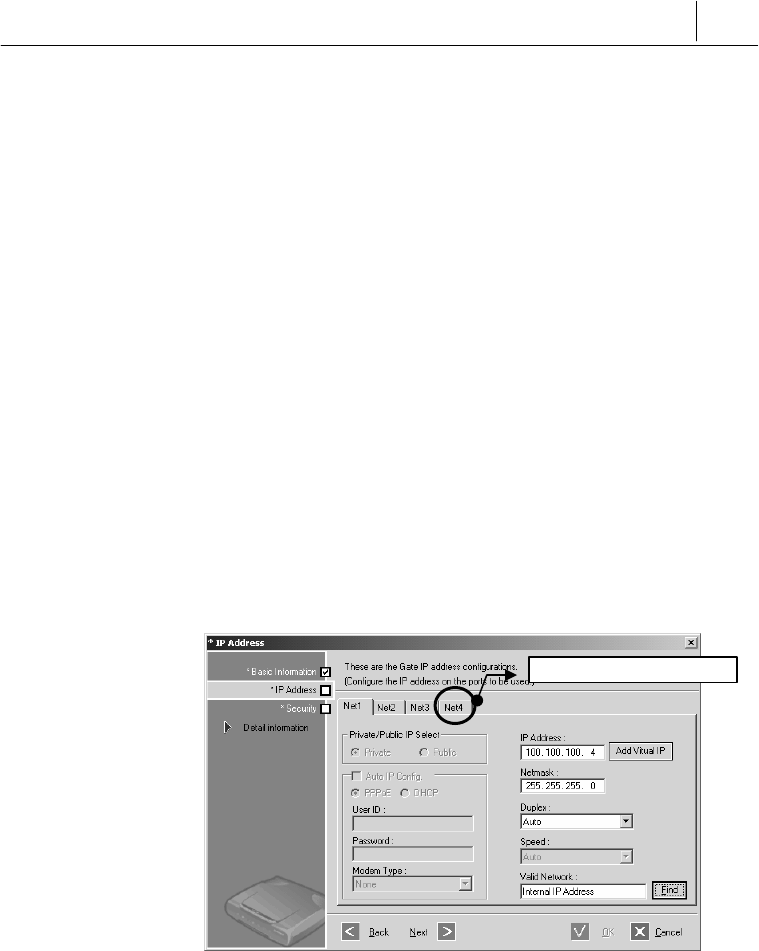
4-7
4.3 SecuwayGate 100 IP Address Change
Procedures
No SecuwayGate 100 console command can change the current
IP address of SecuwayGate 100. Only the administrator of
SecuwayCenter 2000 is authorized to change the IP address of
SecuwayGate 100.
The SecuwayCenter 2000 administrator can change the IP
address of SecuwayGate 100 in the following ways.
1. Start the SecuwayCenter 2000 (run SecuwayCenter 2000
Server → Secuway Center 2000 Client.) and select
SecuwayGate 100 of which IP address you want to change.
2. Double-click the selected SecuwayGate 100 and move to the ‘IP
Address’ step. The ‘IP Address’ window appears.
Select the tab (Net1, Net2, Net3, and Net4) for the port. Enter the
new IP address in the ‘IP Address’ field, and click [Next]. Click [OK]
in the window that appears after you click [Next].
Note that you have just edited the database information, and now
you need to send the new IP information to SecuwayGate 100.
3. To send the new IP information to SecuwayGate 100, right-click
SecuwayGate 100 in which you have changed the IP address
Disabled on the 3 Port System

4-8 Chapter 4
Operating SecuwayGate 2000
from the SecuwayCenter 2000 menu and ‘Resend Information’
from the popup menu list.
4. Before you can use the changed IP address in SecuwayGate 100,
you need to restart SecuwayGate 100.

4-9
4.4 Security Policy Change Procedures
To apply a changed security policy to SecuwayGate 100 after
changing the security policy in SecuwayCenter 2000, select
<Security Policy> → <Apply> from the menu of SecuwayCenter
2000 while the communication between SecuwayCenter
2000 and SecuwayGate 100 is working properly.
For more detailed procedures, refer to the SecuwayCenter
2000 Guide.
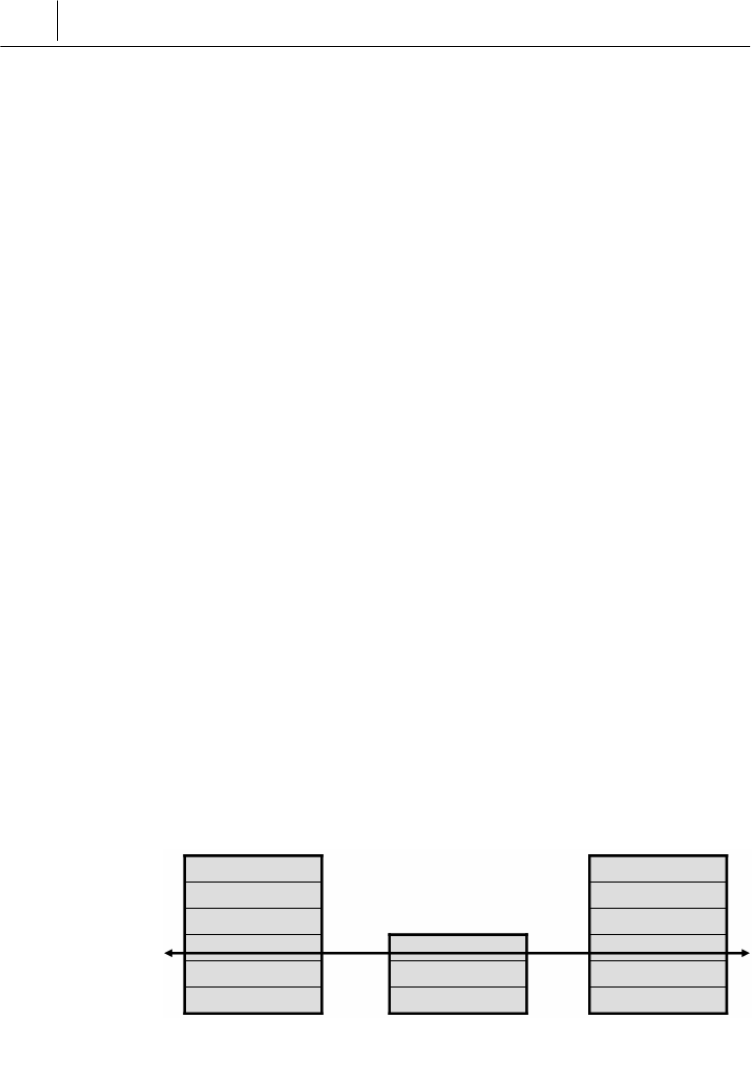
4-10 Chapter 4
Operating SecuwayGate 2000
4.5 Content Security
Content security applies the state analysis method to the
application-level to analyze and control the contents of the packet. It
refers to a function to prevent or convert the access by analyzing the
inbound packets and outbound packets. Among various content
security schemes, SecuwayGate 100 supports FTP filtering,
HTTP content filtering, and SMTP filtering. The packet filters
implemented in a firewall examine and control the incoming packets
with the user-specified filtering rules. SecuwayGate 100 filters all the
incoming and outgoing packets, except a few types of special packets
including broadcasting packet and Non-IP packet.
In general, three types of content security measures are widely used:
Packet Filtering, Application-level Proxy, and State analysis.
SecuwayGate 100 employs the State analysis method. These
three types of filtering methods are briefly explained below.
z
Packet Filtering
Packet filtering refers to the technology that collects the IP header
(which usually contains source IP, destination IP, and port number)
and protocol (e.g. TCP, UDP, ICMP, etc.) header and determines
which network packets to allow through the firewall in accordance
with the predefined security policies. Most routers have packet
filtering as a built-in feature, and most firewall solutions provide
this feature as well.
- Strengths
Because of its simplicity, packet filtering is easy to implement. Since
a few basic rules need to be applied to check packets, packet filtering
is also very fast. Its transparent operation presents another strength
to users.
Sender
Application
Session
Transport
Network
Link
Physical
Packet-filterin
g
Firewall
Packet Filtering
Network
Link
Physical
Application
Session
Transport
Network
Link
Physical
Receiver
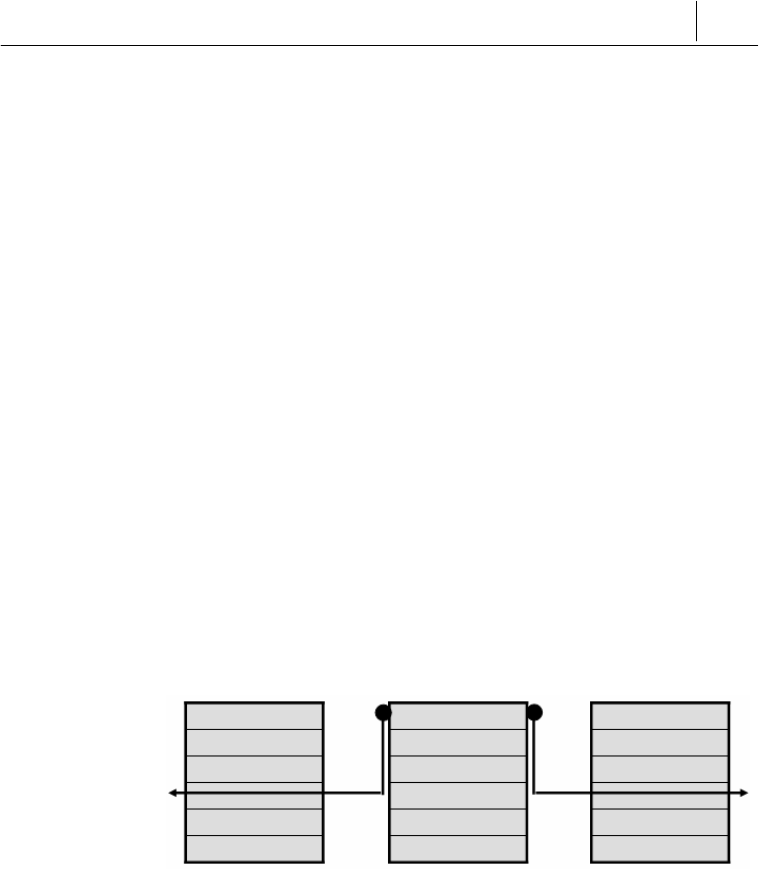
4-11
- Weaknesses
With packet filtering, it is impossible to implement a sophisticated
filtering rule for complicated network or service. Since it passes or
drops according to the limited number of simple access control rules,
packet filtering is too simple to act as a firewall and to protect the
internal resources effectively from the external intrusions.
z
Application-level Proxy
Application-level Proxy acts as a link between an external network
(the client) and a specific internal resource (the application server).
Acting as an application server to the client and as a client to the
application server, the application-level proxy intermediates the
communication between the two entities, as if the client directly
communicates with the application server. The application server
only recognizes that it is communicating with a client of the proxy
server , and does not have further information about the specific
client.
- Strengths
In an application-level proxy firewall environment, only the proxy
server is known to the external network, which enables complete
non-disclosure of the internal computer network system (e. g. IP
address).
- Weaknesses
Since a separate proxy server is required for each application service
Application Proxy Firewall Sender Receiver
Application
Session
Transport
Network
Link
Physical
Application
Session
Transport
Network
Link
Physical
Application
Session
Transport
Network
Link
Physical
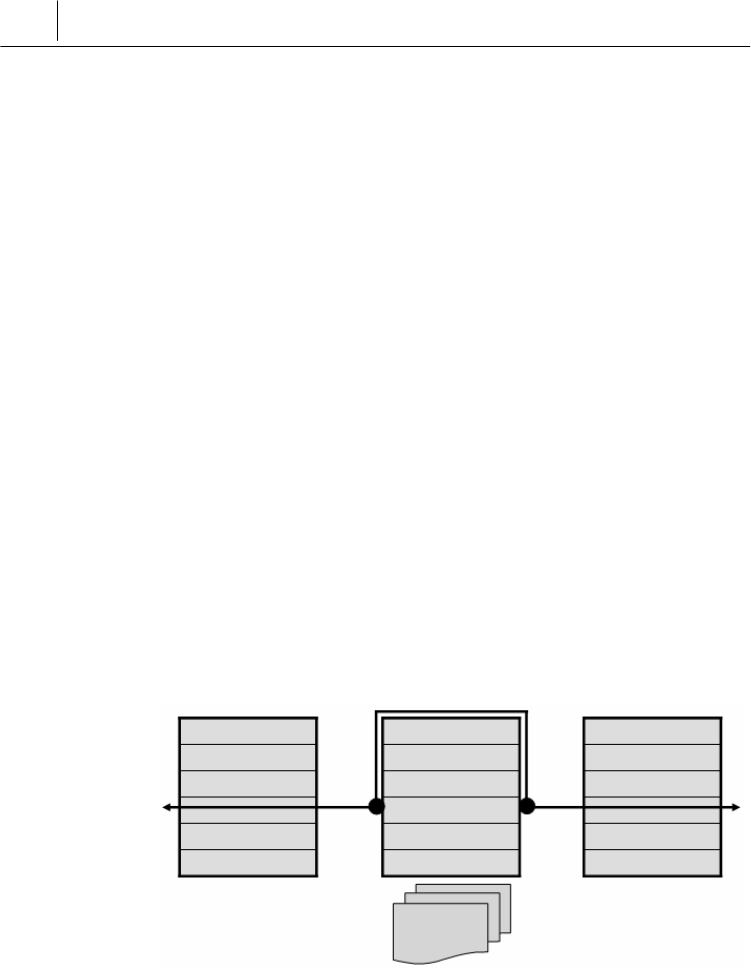
4-12 Chapter 4
Operating SecuwayGate 2000
(e.g. FTP proxy server, TELNET proxy server, HTTP proxy server), it
is required to implement a proxy server for each internet service
provided by your organization.
If your organization decides to introduce a new internet service, it
may be impossible or may take a long time to implement the
relevant proxy server, especially when the internet service your
organization implements is not made of an industry-standard
protocol or unknown source codes.
It is also disadvantageous that each application requires a separate
user authentication process. In addition, the client software or user
module needs to be modified in most cases.
z
State analysis
State analysis does more than simply filter packets with the
information within the packet headers. It interprets and examines
the whole contents of a packet, from the network layer to the
application layer. It keeps track of incoming packets over a period of
time and determines whether to allow the packets to pass through
the firewall.
For example, the first packet received in a session is compared with
the pre-configured set of access rules and the packet information is
added to the state analysis table. Once it is determined whether to
pass the first packet through the firewall, and the following packets
are automatically passed or dropped according to the results of the
state analysis. When the session is closed, the state information
entry in the state analysis table is deleted, but a set of derivative
access rules from the analysis results is reflected the state to enable
dynamic packet filtering.
Application
Session
Transport
Network
Link
Physical
Application
Session
Transport
Network
Link
Physical
Application
Session
Transport
Network
Link
Physical
Maintain state
analysis table

4-13
You can also gather similar state information from the application
data of a stateless protocol(e.g. UDP or RPC) packet. If an
application service requires inspection against all application data, it
is also possible to apply additional application-level processing to
each packet for inspection.
In short, state analysis basically adopts the packet filtering
technique and imitates application-level proxy technique to
interpret and filter application data with far less overload than the
application-level proxy. In comparison with the application-level
proxy, a state analysis-based firewall offers a similar filtering
capability but with much more enhanced performance. The
transparent packet filtering feature for user applications is also a
good reason to choose state analysis.
Based on this state analysis technique, SecuwayGate 100 offers
you highly efficient filtering mechanism and powerful content
security.

5-1
C
Ch
ha
ap
pt
te
er
r
5
5
C
Co
on
ns
so
ol
le
e
C
Co
om
mm
ma
an
nd
ds
s
In order to use the console commands in SecuwayGate 100,
you must connect the PC to the Console port at the rear of the
SecuwayGate 100.
『Chapter 5 Console Commands 』describes how to log in to
SecuwayGate 100 and use console commands with the Hyper
Terminal program.
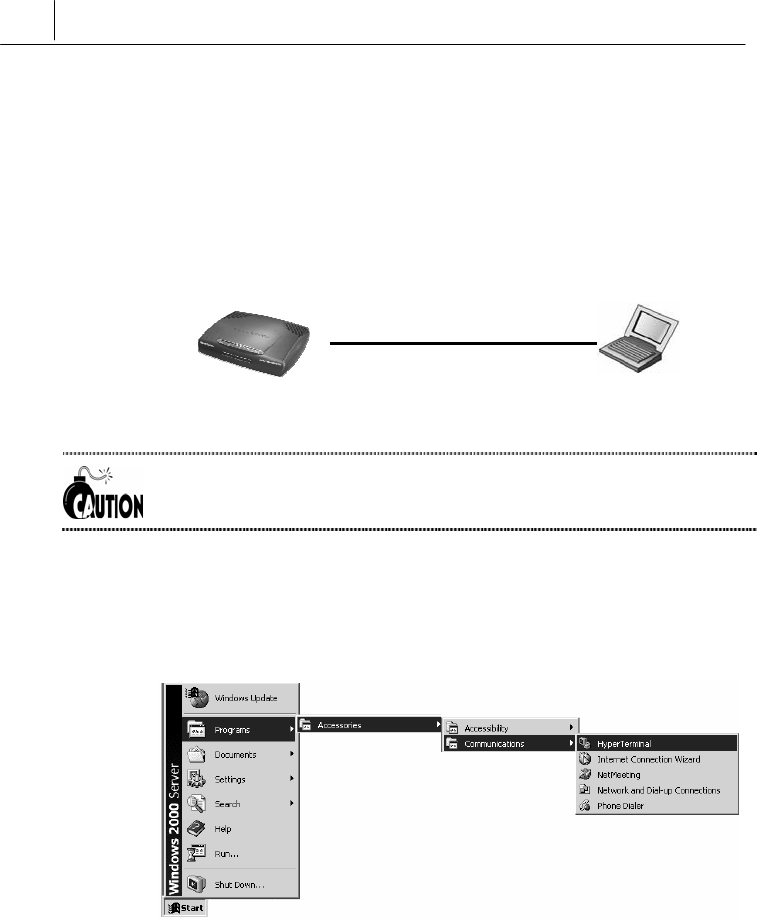
5-2 Chapter 5
Console Commands
5.1 Connecting SecuwayGate 100
z
Step 1. Running Hyper Terminal Program
Connect the console port of SecuwayGate 100 and the
connector linked to the serial port of a laptop or PC.
SecuwayGate 100 PC used to execute console commands
A Administrators connect to SecuwayGate 100 from a host in the
protected network or form a PC installed with SecuwayClient 2000
Once you have established the connection, execute the Hyper
Terminal program by selecting <Start>Æ <Programs>Æ
<Accessories>Æ <Communications>Æ <Hyper Terminal> in the
PC, which you will use as a console window.
z
Step 2. Configuring Hyper Terminal Environment
Once the Hyper Terminal is executed, select an icon and configure
the connection environment in the order of ‘Connection name’ Æ
‘COM port’ Æ ‘Port properties’
- Connection name entry
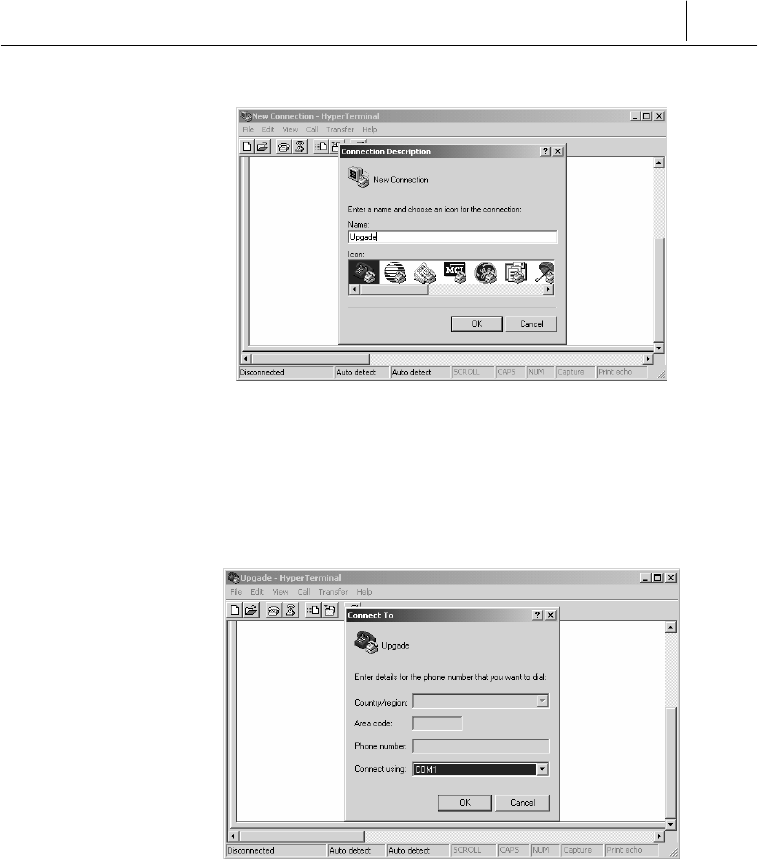
5-3
In this example, we entered “Upgrade” for the connection name. You
may choose any name you want. Then click OK. The following
dialogue box for setting the port to use for the connection will
appear.
- Com port setting
Select the port to connect. For connecting to the console port, direct
connection to COM1 or COM2 is usually selected. After checking the
actually connected port, click OK. Then the environment for the port
to connect will be set as follows.
- Setting environment for the connection port
When you select the port, the following dialogue box for setting
environment for the port will appear. Configure it as shown in the
figure. Be sure to set the bit per second to 38400 and select None for
the Flow control. Otherwise normal connection is disabled for some
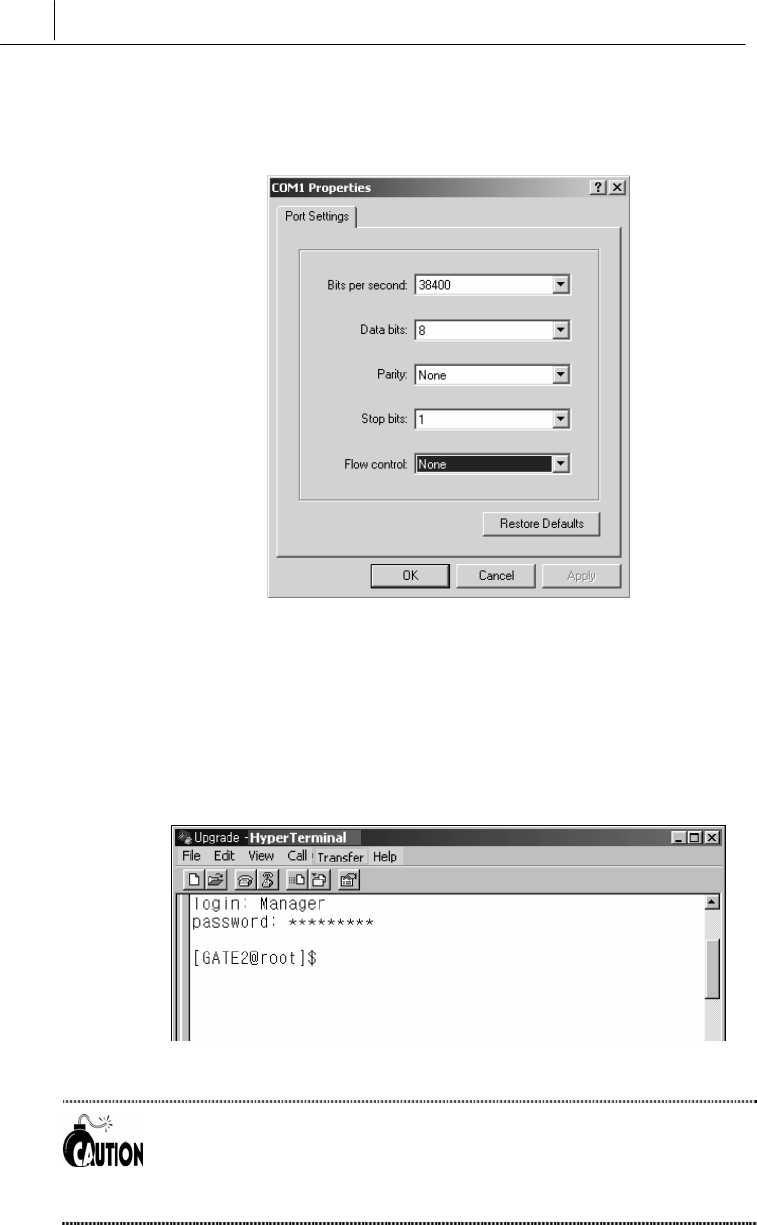
5-4 Chapter 5
Console Commands
cases. Therefore you should set it just as indicated in the following
figure.
z
Confirming Correct Connection
After finishing the hyper-terminal settings, you will be able to log on
as shown below. For login ID and password, you may enter the ones
that have been previously issued from the master token issuer in
SecuwayCenter 2000.
The SecuwayGate 100 will only accept 3 failed login attempts for the
Security Administrator account, and will the deny login attempts for a period
of five minutes. This functionality can be disabled by the Security
Administrator for that SecuwayGate 100, if required.(see “sv
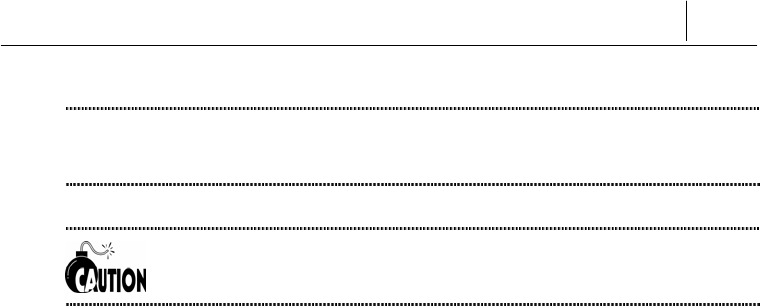
5-5
command” in chapter 5 Console Commands)
When the SecuwayGate 100 Security Administrator account is inactive
for 2 minutes, then it will logoff automatically.

5-6 Chapter 5
Console Commands
5.2 How to Use Commands
You can use console commands when your PC is connected to the
console port of SecuwayGate 100 or when a remote PC is
enabled to connect to a Telnet program from the outside.
A Administrators connect to SecuwayGate 100 from a host in the
protected network or from a PC installed with SecuwayClient 2000
The term ‘SecuwayGate’ mentioned in this document is a common
designation of SecuwayGate 2000, SecuwayGate 1000,
SecuwayGate 100 and RenoGate.
The List of Commands
Command Purpose
addlog
SecuwayGate forcibly generates a dummy log,
and transmits the log to SecuwayCenter 2000.
The log is used for verifying normal operation of log
transmission.
advanced
When functions are executed such as input,
correction and deletion of routing scripts, the
routing scripts stored in SecuwayCenter 2000
or Flash are executed upon system restarting or
receiving the policies, and control operation of
different services (daemons).
arp The command is similar to Linux arp command. The
command displays arp table, and adds or deletes arp
entries.
arp_hash Caches arp to determine use of arp, and searches for
the current arp cache.
authinfo
Displays the job list under user authentication (e.g.,
IP address, processing status, error number,
timestamp, retrial count and message length) and
the information list of user authentication in the
active session (i.e., session list of each user ID).

5-7
autoup Automatically upgrades firmware or harmful
databases.
bypass
Ignores the security policies applied to
SecuwayGate, and changes communication
between specific networks to bypass. This command
is available before communication with
SecuwayCenter 2000 after entering
SecuwayGate setup information.
capture
Displays brief header information of IP and TCP for
packets entered/displayed in/on specific IP or port.
Executing this command may degrade performance
of the system, and is only recommended for simple
packet inspection. The function is released with
'capture 0.'
center
Displays or changes IP address of
SecuwayCenter 2000 currently stored in
SecuwayGate.
change_ip Changes SecuwayGate IP and
SecuwayCenter 2000 IP set on
SecuwayGate objects.
chk_gateway Searches for a gateway for specific IP on specific
interface.
cpuinfo Displays information of CPU and system of
SecuwayGate.
crypto
Tests the boards upon acceleration of
encryption/decryption. Devices available of testing
include FSC2002, Bud-F(FACE), and CAFE.
Algorithm test is available for FSC2002 only, and
stress test for FACE or cafe only. Every 5000th
testing indicates success or failure of
encryption/decryption.
date Converts the time currently set on the gate into UTC
and RTC type, or sets the time.
debug Converts the time currently set on the gate into UTC
and RTC type, or sets the time.
del Erases and initializes the details including IPSec-
relevant tables. The table initialized for respective
option is as follows:
delses Erases the session information.

5-8 Chapter 5
Console Commands
dev It is possible to show information of devices and
systems, and change attributes (e.g., duplex and
speed) of the interface.
dhcp dhcp ip Shows or changes allocation information.
entry Shows items in the session table.
eraseobj
Erases the objects containing the security
information of SecuwayGate, and initializes
SecuwayGate.
failover Displays the failover operation mode of the current
SecuwayGate on the screen.
findcenter
Searches for the location (interface number) of
SecuwayCenter 2000 communicating with
SecuwayGate, or stops searching.
get_arp Transmits ARP Request of concerned IP to the
specified interface.
help Displays a list of available commands.
history Shows the commands used on the shell so far.
icmp
Defines whether allowing ICMP communication or
not. The command is only available before
communication with SecuwayCenter 2000
after entering the initial setup information.
ipconfig
Same as existing Linux command. The command is
used when showing configuration information of the
whole interfaces, setting IP of specific interface or
stopping operation.
import Initializes SecuwayGate with the initial files of
SecuwayGate issued from SecuwayCenter
2000, or enters the certificate.
ip_hash
Displays device (interface) information of a certain
IP on the screen, which is kept for a certain period
(as a hash table format). This command is mainly
used for verifying IP validity of the concerned device.
ip_verify Inspects valid network belonging to IP address.
lb Shows the Line Load Balancing status. Inspects the
status of the leased line/VPN line/router backup
when using the line option.
lbinfo Displays user ID and password of a line where Line
Load Balancing is set to..
lineinfo Same as lb line command.

5-9
log It is possible to check logs accumulated on
SecuwayGate, which have not been transmitted
to the log server.
lookup The function finds IP address and MAC address
corresponding with the host name, and displays the
results on the screen.
ls Same as the help command.
mainfo The function controls starting or aborting MA, and
checks the system status information managed by
MA.
netstat Displays the socket information of SecuwayGate.
nvram_info Displays the nvram information.
obj Shows the objects of Gate.
ping
Operates in a manner same as normal ping. Ping
uses the ICMP protocol's mandatory
ECHO_REQUEST datagram to elicit an ICMP
ECHO_RESPONSE from a host or gateway.
ECHO_REQUEST datagrams (“pings”) have an IP
and ICMP header, followed by a “struct timeval” and
then an arbitrary number of “pad” bytes used to fill
out the packet.
pppoe Verify the status of PPPoE.
proxy_arp Adds or deletes concerned entries to or from Arp
Proxy Table, or searches for the entries from the
table and displays the results.
proxy_ip Displays the Proxy IP information of the concerned
IP on the screen.
reset Reboots SecuwayGate.
rhosttab The command is relevant to the hash table to seach
for SA of the remote host.
romc Displays the SecuwayGate flash memory
information.
route Shows the routing table registered on the system,
and adds or deletes routing information.
session Shows the session table.
set_mac Changes the MAC address of SecuwayGate.

5-10 Chapter 5
Console Commands
status
Displays the system information of
SecuwayGate, statistical information of packets
for each protocol, and the packet filtering status.
Dependent upon the options, it is possible to verify
the detail statistical data, the interface status and the
processing rate about transmitted and received
packets of the IP/TCP/UDP/ICMP protocols.
sv The command controls each flag value.
sysbg Displays the system log messages stored in the
backup SRAM of SecuwayGate 1000/2000 on
the screen.
syslog Displays information of IP/port, number of
SecuwayCenter 2000 logs and the log types of
the server relevant to Syslog.
task Viewing the kernel task list
ted
SecuwayGate performs TED for the gate set on
the IPSec gate list based on the IPSec gate list set to
SecuwayCenter 2000 or GateAdmin, and
manages information of the counterpart gate in the
table. The ted command verifies the TED table (or
the VPN table) status, or manually performs TED.
timereq
Tests SecuwayCenter 2000 and the time
service. Upon system booting, SecuwayGate first
transmits the TimeRequest packets to
SecuwayCenter 2000 to synchronize the time
with SecuwayCenter 2000.
traceroute
Plays a role same as the traceroute command on
Linux. The Internet is a large and complex
aggregation of network
hardware, connected together by gateways.
Tracking the route one's packets follow (or finding
the miscreant gateway that's discarding your
packets) can be difficult. Traceroute utilizes the IP
protocol `time to l' field and attempts to elicit an
ICMP TIME_EXCEEDED response from each
gateway along the path to some host.

5-11
trap_buf
Once a trap takes place such as memory violation,
the command stores the monitor message in the
consoles as well as the flash memory in object id 14.
Therefore, it is possible to obtain various
information by analyzing the dump message.
upgrade
The command upgrades the firmware. The
command first runs the upgrade daemon to the gate,
and receives and processes images when firmware
files are transmitted to the network. UDP protocol
port 9876 is used for upgrade. Please note that data
relevant to upgrade is not affected by the security
policies.
version Displays the firmware version information, the
compiling date and the compiling option
information of SecuwayGate.
view_traffic It is possible to verify the current CPU utilization,
memory utilization, number of sessions, and traffics
of SecuwayGate.
xurl
Checks the harmful site database provided from
SafeNet for any URL, or inspects the autonomy
grade of the concerned URL. The harmful site
database contains overseas sites, not domestic sites.
xurl_db Manages the harmful site database.
ldap Gains access to the LDAP server to search for CRL.
p1info Shows the detail information of SA in step 1.
pki Shows the PKI information.
pic Shows information of PIC operation and SA. PIC is
used for authentication of Remote Access Client in
GateAdmin environments.
sainfo Shows the SA-relevant table.
secinfo Shows the IPSec-relevant table.
view_tid Displays the TID table on the screen.
Detailed Description of each Commands
Please refer to “SecuwayGate Console Commads” maual for futher
information on how to use SecuwayGate 100 console commands

6-1
C
Ch
ha
ap
pt
te
er
r
6
6
U
Up
pg
gr
ra
ad
di
in
ng
g
F
Fi
ir
rm
mw
wa
ar
re
e
The firmware of SecuwayGate 100 can be upgraded, if
necessary. The following section describes the firmware upgrading
procedures.
The administrator can load new firmware to upgrade functions
provided by SecuwayGate 100.
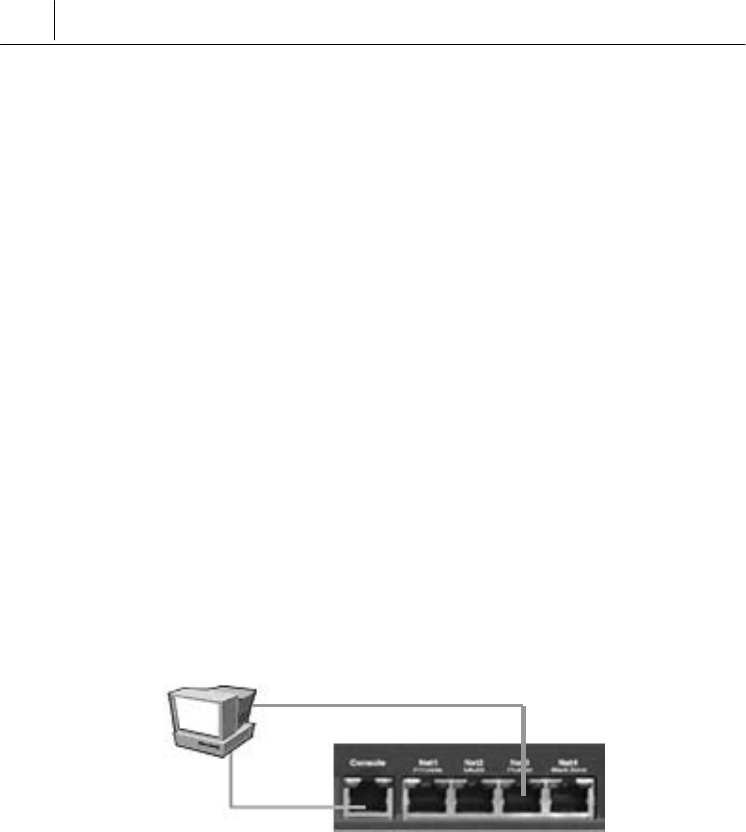
6-2 Chapter 5
Console Commands
6.1 Preparations for upgrade
Prepare PC with the HyperTerminal program and SecuwayGate
100 firmware loading program Lanload.exe which is included in
the installation CD.
Cable Connection
1. Connect the serial port of the PC and RS-232C port of
SecuwayGate 100 with the console connector as shown in the
following figure. (Use normal LAN cable as the connector).
2. Connect any one of the ports Net1, Net2, Net3, and Net4 of
SecuwayGate 100 with the LAN port of PC. For explanation
purposes, port Net3 is chosen in the figure.
LAN Port
Serial Port
RS-232C Port
Net3 Port
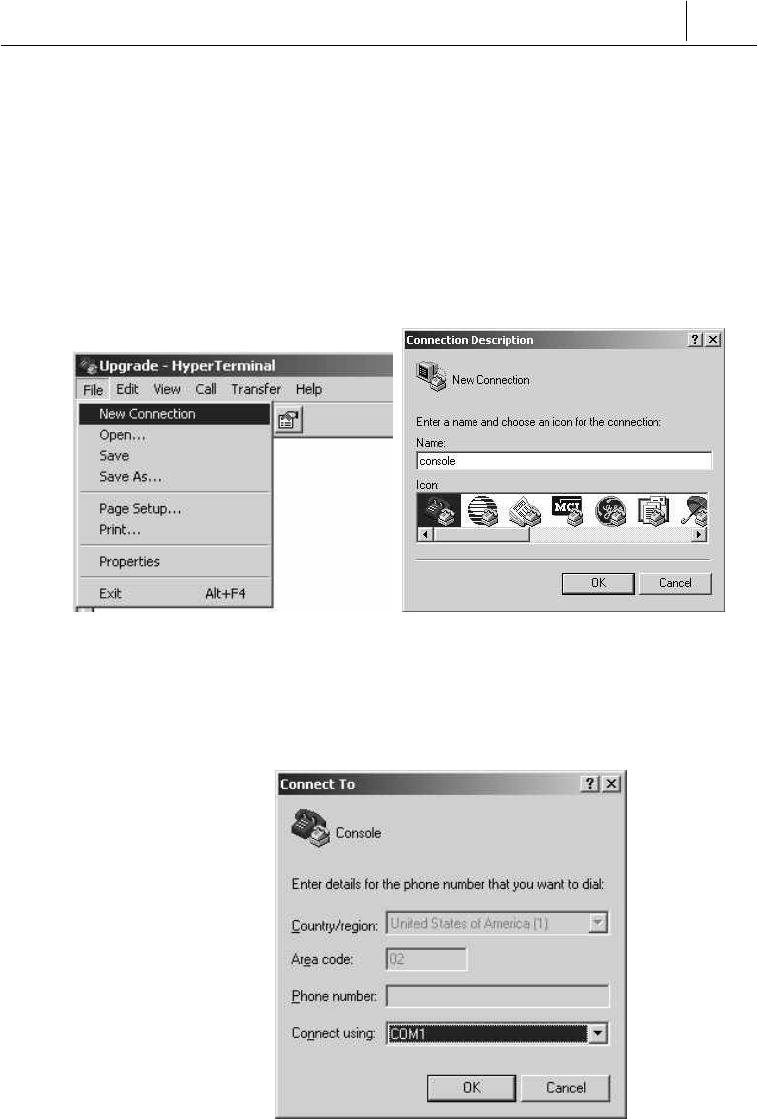
6-3
6.2 Loading Firmware
Configuring HyperTerminal
1. Select [New Connection], input the name for the connection, and
click OK.
2. Configure Modem to Connect to COM1. (This may vary depending
on your PC configuration.)
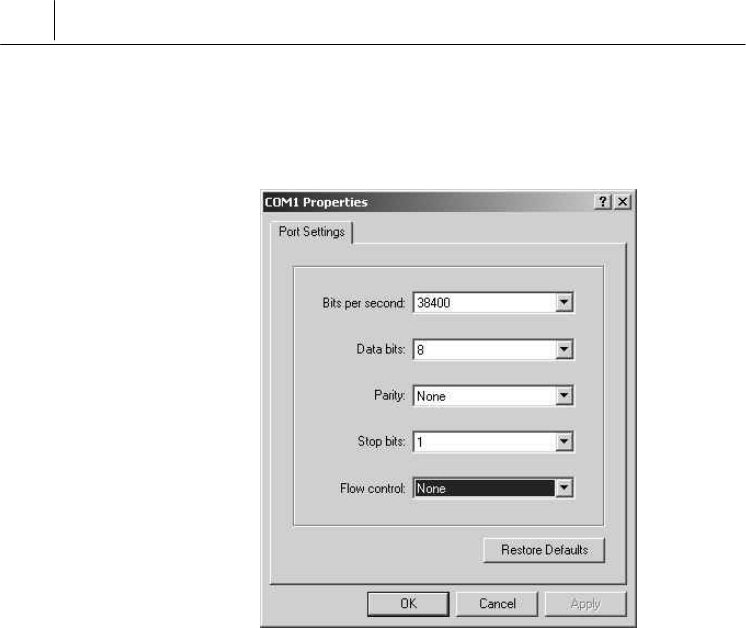
6-4 Chapter 5
Console Commands
Setup port Net3onfiguration as shown in the following figure.
3. Click OK, and the HyperTerminal window will be displayed. In the
window, press <Enter> key to connect to SecuwayGate 100,
and a screen will be displayed allowing ID and password input.
6.3 Logon SecuwayGate 100
1. In the Hyper Terminal window, enter the registered login ID and
password.
2. Specify the port number of SecuwayGate 100 used to
upgrade the program in the following format (‘upgrade 2’, in this
case). Here ‘0’ means the port Net1 on the rear side, and ‘1’, ‘2’,
and ‘3’ refer to Net2, Net3, and Net4, respectively. In this case,
the Net3 is connected to the internal LAN, therefore you need to
type “upgrade 2” when prompted.
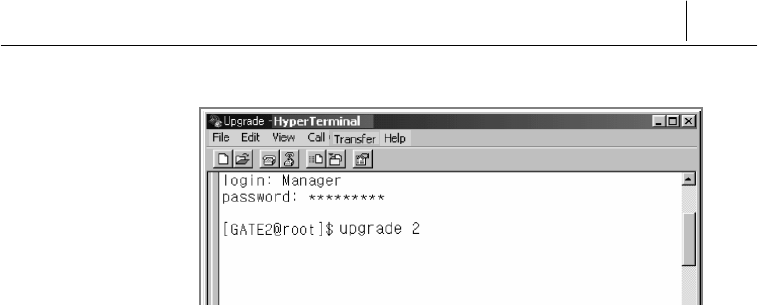
6-5

6-6 Chapter 5
Console Commands
6.4 Executing ‘Upgrade’ File
The ‘upgrade’ file is used to upgrade the existing firmware of
SecuwayGate 100.
Two firmware upgrade methods are supported in SecuwayGate
100: Initial and Normal. You can select either upgrade type in the
‘FirmUpgrade’ window, which appears when you execute
FirmUpgarde.exe.
Initial Refers to upgrading in debug mode. Debug mode is a
pre-operation phase in which SecuwayGate 100
is completely reset. If you upgrade a firmware in
debug mode, the new firmware is automatically
reloaded and adopted in SecuwayGate 100.
Normal Refers to upgrading the firmware to
SecuwayGate 100 currently in operation. T
upgraded firmware is adopted only when the
admionistrator resets SecuwayGate 100
manually.
“Normal(N)” firmware upgrade type is widely used for its convenience.
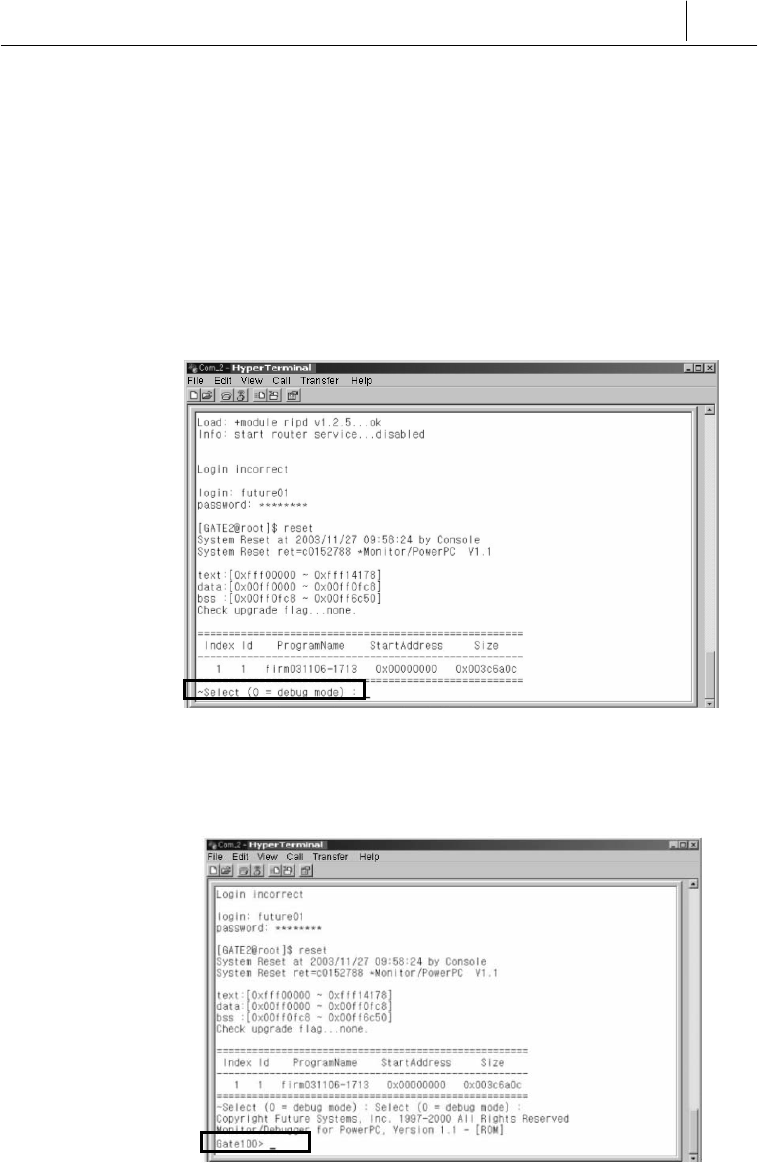
6-7
6.4.1 Upgrading Firmware
Initial (I) Upgrade Type
1. Reset SecuwayGate 100. When you reboot SecuwayGate
100, press “~” key in the Hyper Terminal window and enter the
debug mode. The following figure is displayed:
2.Type “0” to enter the debug mode, and type “0” again. The Gate
100 prompt appears.
3. Type “x 0” and press ‘Enter’.
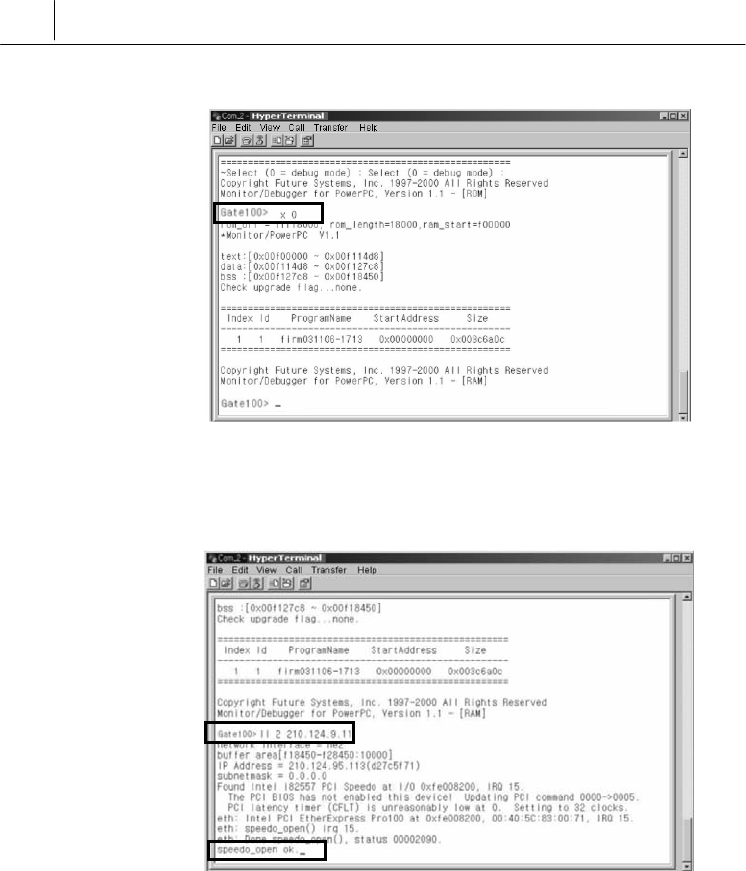
6-8 Chapter 5
Console Commands
4. Type “ll 2 IP address of SecuwayGate 100” and press ‘Enter’. The
“speedo_open ok.” message is displayed.
5. Execute FirmUpgarde.exe in a PC to which SecuwayGate 100
is connected. The ‘FirmUpgrade’ window appears. In the ‘Gate IP
Address’ field, enter the IP address of the Net3 port. Select ‘Initial’
for the ‘Upgrade Type’ field. The ‘Upgrade Port’ is already set to
‘9876’. If you edit this value, the system may not work properly.
Click [Start].
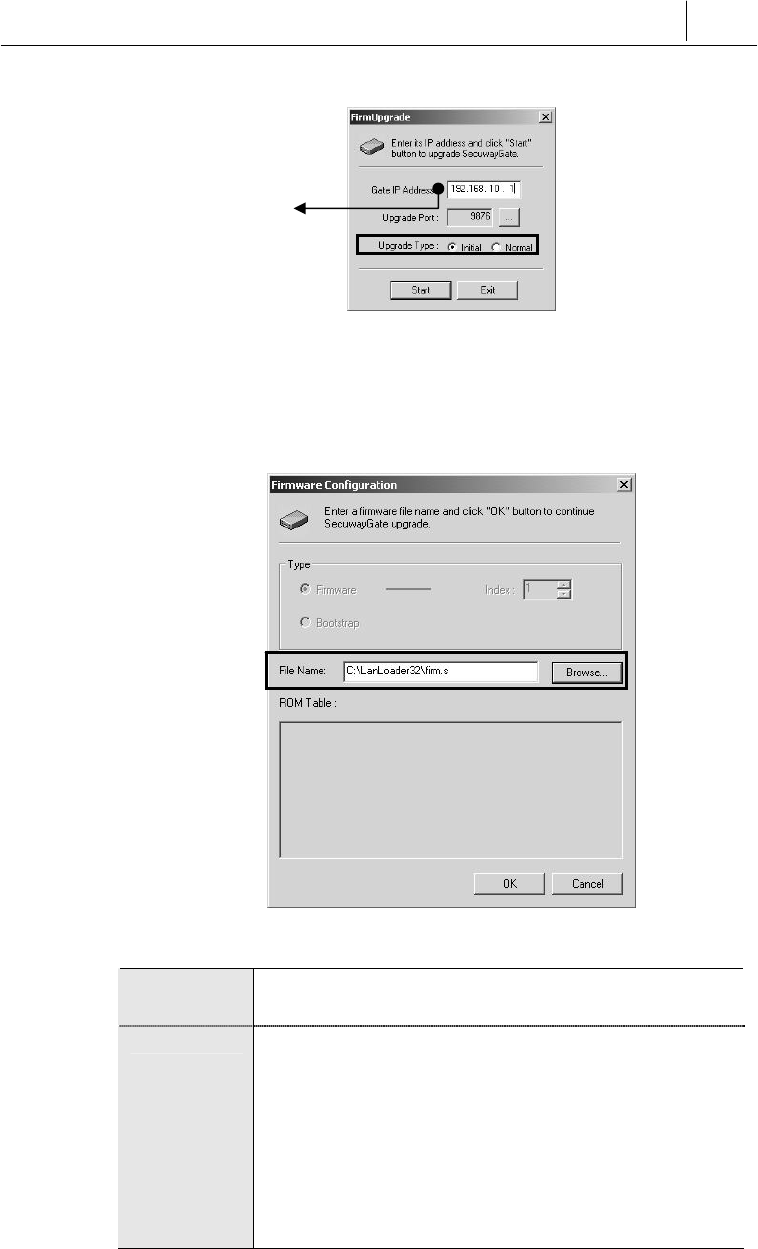
6-9
6. The ‘FirmUpgarde Configuration’ window appears. Specify the
location of the firmware upgrade file in ‘File Name’ by clicking
[Browse] and selecting the file. Click [OK].
Firmware Transfers the firmware as well as the DB that blocks
harmful sites to SecuwayGate 100.
Index Indicates the memory allotment index of
SecuwayGate 100. While the index No. 1~8 are
pre-assigned to store the firmware, the index No. 9 is
assigned to the DB for blocking harmful sites.
Usually, No. 1 is used to store the firmware. It is
because SecuwayGate 100 starts to check the
availability of the firmware with the index No. 1 and
loads the first one available in the index. If no
Enter the IP address of
Net3 port
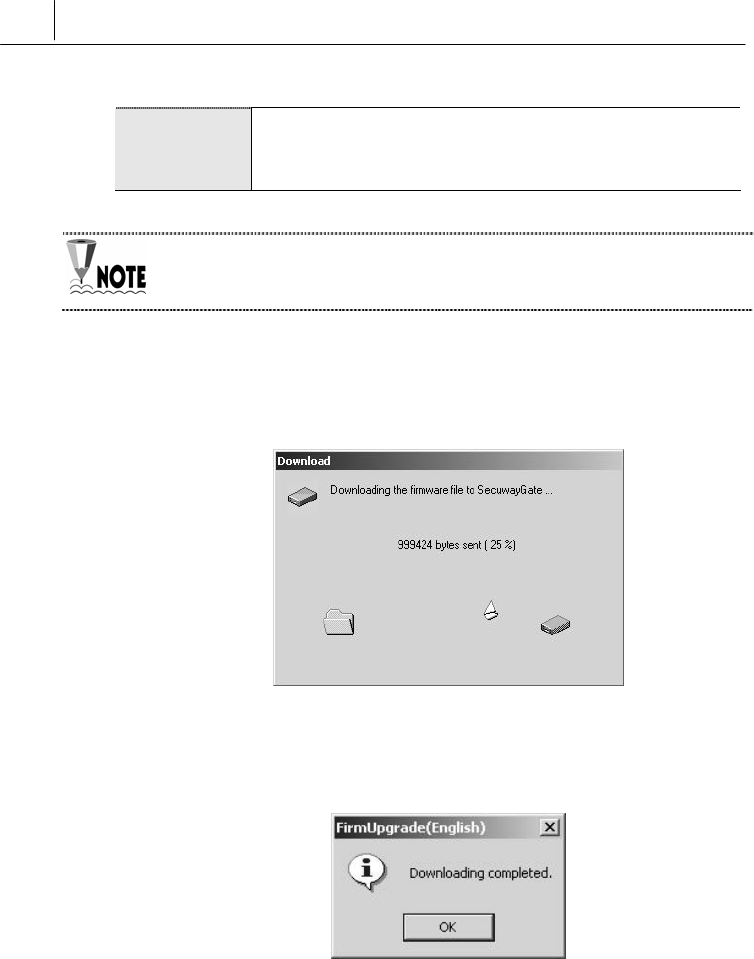
6-10 Chapter 5
Console Commands
firmware is available in the index No. 1, it checks the
index in the order of No.2, 3, 4, … 8 to load the first
available firmware.
The name of a firmware file is either ‘first’ or ‘firm’. If you are updating the
firware in initial mode, you must select the firmware named as ‘first’.
Click [OK]. The ‘Download’ window appears to show you the process
of transmitting the firmware file to SecuwayGate 100 as shown
below.
Once the file transmission is completed, “Download completed”
message appears.
If the firmware transmission is completed, you will see the following
messages in the Hyper Terminal window, and SecuwayGate
100 is automatically reset.
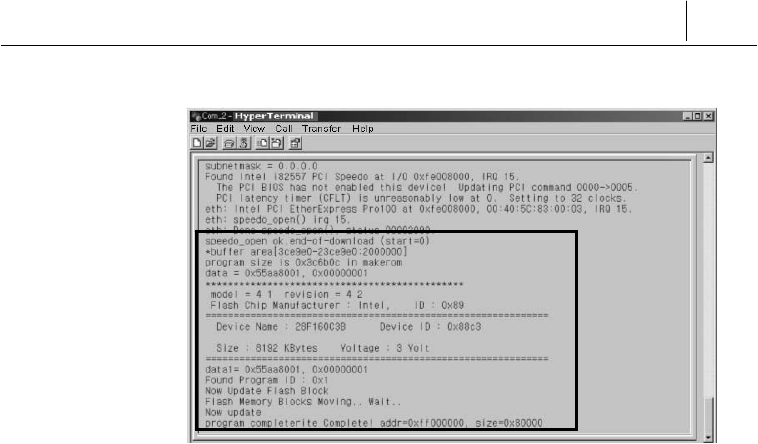
6-11
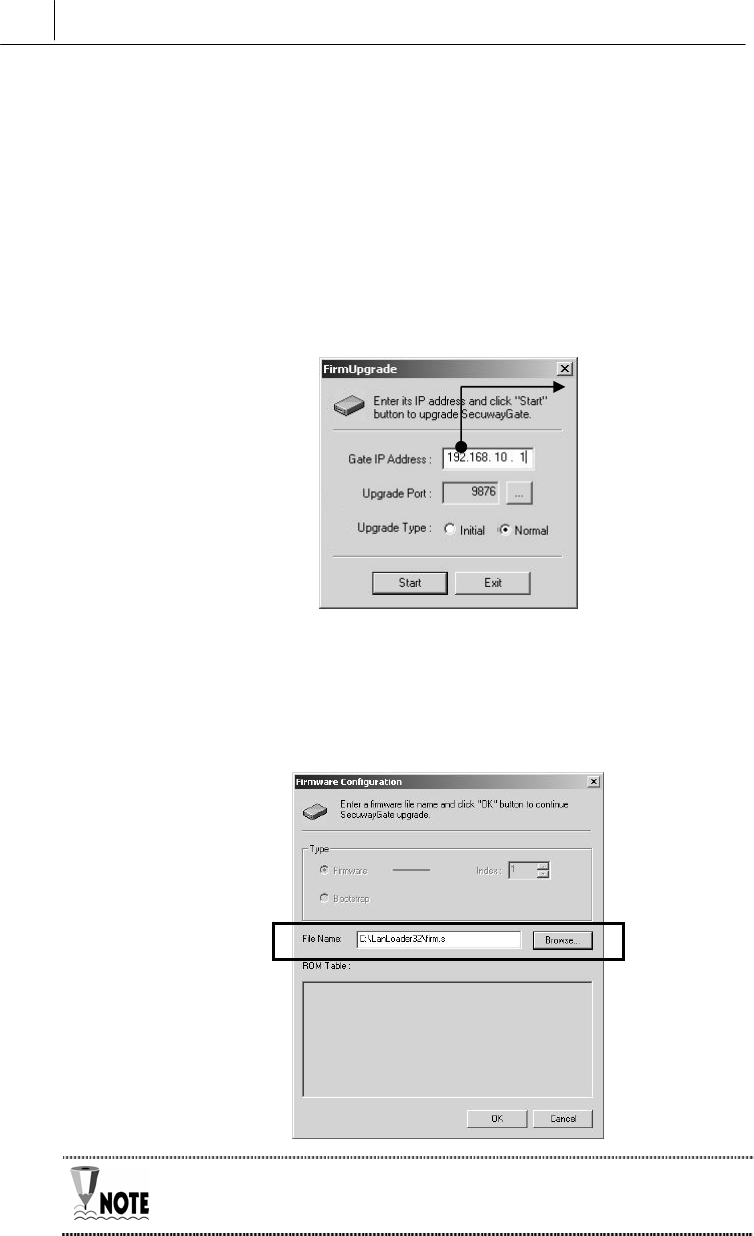
6-12 Chapter 5
Console Commands
Normal (N) Upgrade Type
1. Execute FirmUpgarde.exe in a PC to which SecuwayGate 100
is connected. The ‘FirmUpgrade’ window appears. In the ‘Gate IP
Address’ field, enter the IP address of the Net3 port. Select the
‘Initial’ for ‘Upgrade Type’ field. The ‘Upgrade Port’ is already set to
‘9876’. If you edit this value, the system may not work properly.
Click [Start].
2. The ‘FirmUpgarde Configuration’ window appears. Specify the
location of the firmware upgrade file in ‘File Name’ by clicking
[Browse] and selecting the file. Click [OK]
The name of a firmware file is either ‘first’ or ‘firm’. If you are updating the
firware in normal mode, you must select the firmware named as ‘firm’.
Enter the IP address of
Net3 port.
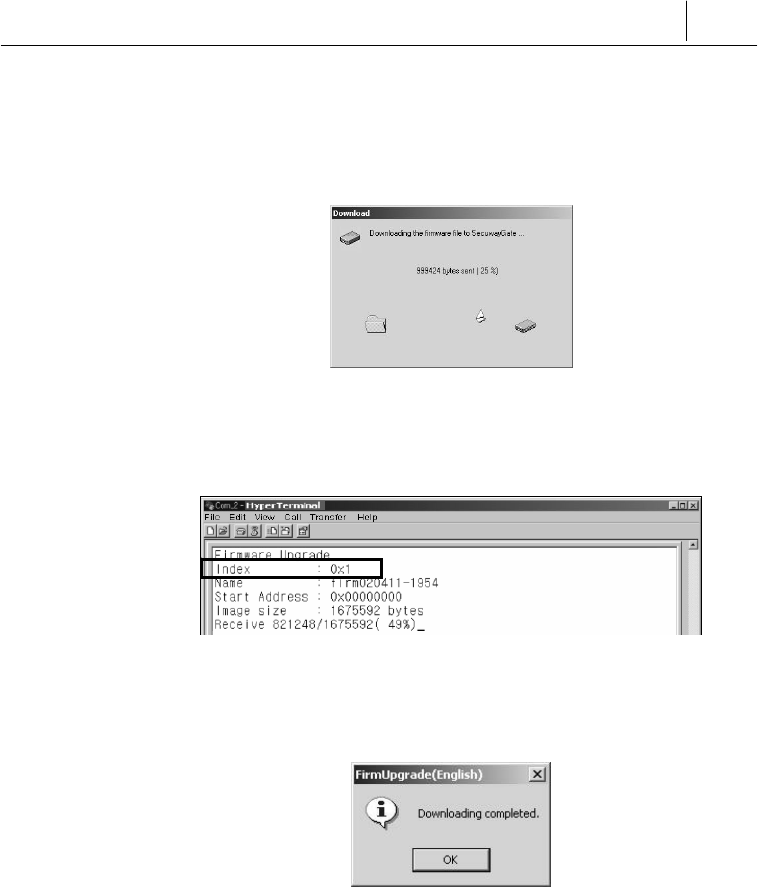
6-13
Click [Transmit]. The ‘Download’ window appears to show you the
process of transmitting the firmware file to SecuwayGate 100
as shown below
You can also verify the firmware downloading process in the “Index:
0x1” section of the Hyper Terminal.
Once the file transmission is completed, “Download completed”
message.
3. If the firmware transmission is completed, execute “reset” in the
Hyper Terminal. To apply the ungraded firmware, you must execute
“reset”command.
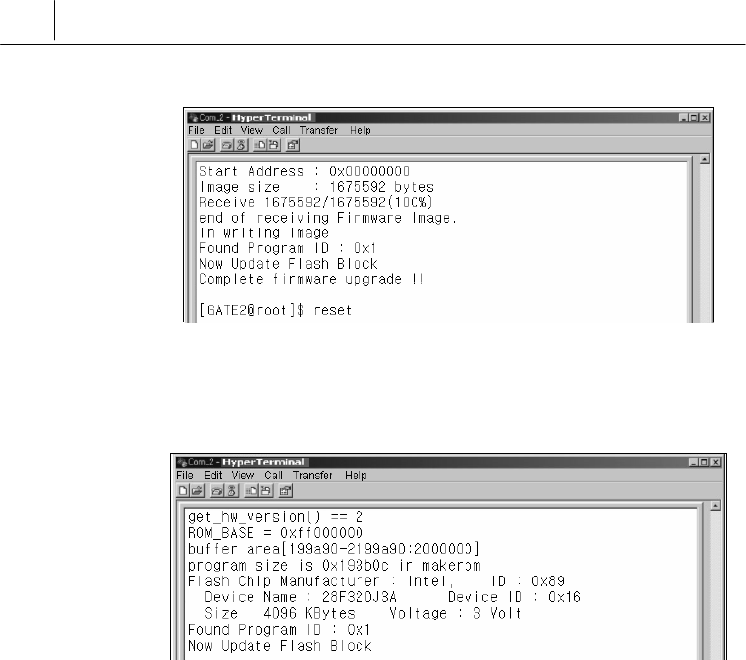
6-14 Chapter 5
Console Commands
4. SecuwayGate 100 is restarted once the firmware has been
upgraded.
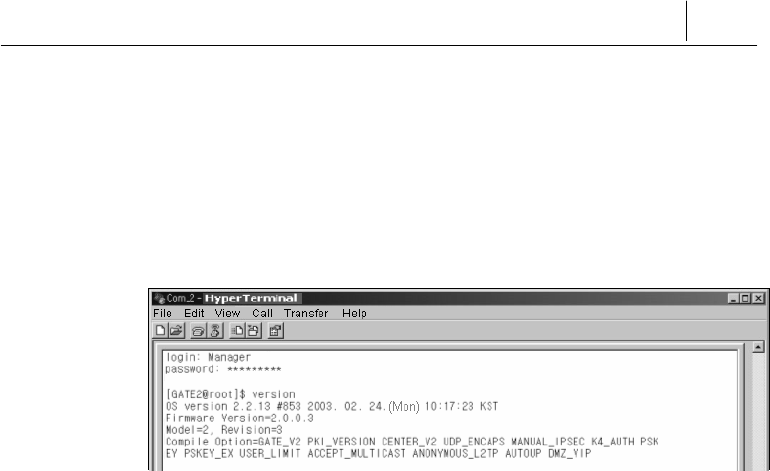
6-15
6.5 Checking Firmware Loading
The version of the firmware can be checked through HyperTerminal
on the PC connected to the SecuwayGate 100 console. To check
the version of the firmware, type the “version” command.

C
Ch
ha
ap
pt
te
er
r
7
7
Q
Q&
&A
A
A
Ab
bo
ou
ut
t
S
Se
ec
cu
uw
wa
ay
yG
Ga
at
te
e
1
10
00
0
1) I want to change the IP address of the SecuwayGate 100 which is
in use. What should I do?
In order to change the IP address of the SecuwayGate 100
which is in use, select the [Modification] feature in the [Gate
Management (G)] in SecuwayCenter 2000. After changing
features, you must send the changed features using [Resend (R)],
and in particular when you have changed the IP address, you must
run [Gate Restart (T)].
2) Is it mandatory to use the four ports, i.e., Private, Multi, Public, and
Black Zone ports at the rear for their specified purposes?
The four ports Net1 (Private), Net2 (Multi), Net3 (Public), Net 4
(Black Zone) are specified for user convenience, and you don’t have
to use them for their specified uses. In actual application, the
administrator may use the four ports in his/her discretion for
operational convenience.
Because the four ports at the rear are controlled by valid network
setting and security policy in SecuwayCenter 2000, they may
not be used for Private, Multi, Public, and Black Zone as specified,
but for separating the network into four networks to control each
network individually.
3) How can I change the security policy of SecuwayGate 100?
A
Ap
pp
pe
en
nd
di
ix
x
A
A
Q
Q&
&A
A
A
Ab
bo
ou
ut
t
S
Se
ec
cu
uw
wa
ay
yG
Ga
at
te
e
1
10
00
0

7-2 Chapter 5
Console Commands
After changing the security policy in SecuwayCenter 2000,
send it to SecuwayGate 100 on-line. Then the changed
security policy will be applied immediately. The SecuwayGate
2000 administrator cannot insert or delete a security policy by
accessing through the Console port or Telnet. If the security policy
needs to be changed, you must ask the administrator of
SecuwayCenter 2000 to do it.
4) When moving the SecuwayGate 100 to another place, what
settings should be changed?
You must consider the following two cases when moving the system
to another place. If the TCP/IP related information is changed, you
must change and transmit the IP address or other network
information, before moving the SecuwayGate 100 or you must
have the initial setting smart card reissued from
SecuwayCenter 2000 and then import it into
SecuwayGate 100 after moving.
5) How can I stop the use of
SecuwayGate 100
in emergency?
In order to stop it, you must first discuss with the administrator of
SecuwayCenter 2000 or Gate Admin, and then run the [Stop
Service] in the [Gate (G)] menu in SecuwayCenter 2000
6) is the meaning of the “Valid network” and the reason of setting it
with the issuance of SecuwayGate 100?
Valid network is a set of valid IPs of the hosts connected to each
interface, i.e., Net1, Net2 and Net3. Valid network must be set in
order to decide the paths through which received packets are sent.
By setting the valid network, you can also prevent IP Spoofing by
verifying the validity of the starting IP address. If the valid network
is incorrectly configured, the IP spoofing error message will appear
in SecuwayCenter 2000, and it may cause such problems as
the data accepted on security policy are transferred to other
interfaces and do not arrive at the destination. For details on
setting valid network, please refer to the User’s Guide for
SecuwayCenter 2000 .
7) It is said that SecuwayGate 100 processes the send/receive
packets through the conditional analysis method. How does it
manage sessions? In other words, when is the time that the session
is registered and deleted?
For TCP, the session is registered when the Syn packet is received,
and for UDP, it is registered when the Data packet enters. In both
cases, the session can be registered only when the security policy is
in the “Accept” state in SecuwayGate 100.
The time when the session is deleted is different with Firmware
versions for TCP. In version 1.5, 2.0 and higher, the session is
deleted when the Timeout value of the security policy is exceeded in
SecuwayCenter 2000, or FIN or Reset Packet is received. On
the other hand, in hardware of versions lower than 1.5,2.0, the
session is deleted only when the FIN or Reset Packet is received.
Therefore, when the session finishes abnormally in the PC or server,
the sessions will be accumulated. For UDP, because the session
timeout value is set to 30 seconds regardless of firmware versions,
the session will be canceled when packet transmission time exceeds
30 seconds for the session.
8) What types of L4 switches support load balancing by interoperation
with SecuwayGate 100 (VPN) equipment?
1) Radware: FireProof 2) Piolink: Pinkbox1016
3) Alton: AD3, 180e
9) When should we reboot SecuwayGate 100 due to modification of
information in SecuwayGate 100?
1) When the IP of SecuwayGate 100 is changed.
2) When upgrading firmware.
3) You don’t have to reboot when the valid network is changed.
10) Does the SecuwayGate 100 equipment support line/server load-
balancing feature?

7-4 Chapter 5
Console Commands
SecuwayGate 100 supports both line load-balancing (LLB)
and server load-balancing (SLB).
LLB enables the duplication of the Internet lines with two ADSL
lines, or with one ADSL line and one dedicated line, enhancing
availability of the Internet. LLB decides its line by combination of
the starting IP address and destination IP address, and make it
possible that all communication will be processed through the
remaining line even if one line fails.
SLB checks the availability of the homogeneous servers, enabling
continuous service. The methods of supporting SLB include: server
inspection by using PING to check the activation of the server,
server inspection by checking the use of the service, round-robin
method for service distribution to servers and the number of
sessions method.
11) Does the firewall features of SecuwayGate 100 include blocking
of harmful websites?
SecuwayGate 100 supports the feature to block harmful
websites through HTTP Content filtering function. You can block
the access to the hosts containing specific character strings, or to
specific directories or files. In addition, the feature of filtering
various dangerous scripts (JavaScript, VBScript, etc.) is provided.
12) Can SecuwayGate 100 be operated on other vendors’ NMS
program?
SecuwayGate 100 supports SNMP V1.0 to enable its operation
on other vendor’s NMS’s. However, due to various security
problems, not all SNMP functions are supported. Only viewing is
allowed for most functions.
13) What should be checked, if file upload fails after going through
SecuwayGate 100 using a fixed IP?
For ADSL modems, there is a limit in MTU size. It is typical that the
size is limited for floating IPs, but not for fixed IPs. Samsung ADSL
modems generally fall in this case, but Hyundai ADSL modems are
usually configured to limit the MTU size for fixed IPs by default. If
file upload fails on the Internet or into tunnels after installing
SecuwayGate 100, the ADSL modem must be checked. You
can determine that this is the problem if a file of 1 Kbytes is
uploaded but a file of over 2 Kbytes is not uploaded.
14) Which ports are used for various messengers?
ICQ / AOL: 5190 MSN: 1863
Chollian (CQM) : 1421 Soft Messenger: 5004
Bluebird: 3300 Netsgo (Minigo): 5004
Yahoo: since Yahoo cannot be controlled by port, you should block
cs.yahoo.com or scsa.yahoo.com. However, you must be careful
because if you block these two sites, it may not be possible to access
yahoo.com itself.
For some of the above ports, only the login ports are listed. (If you
block only the login port, access is disabled.)
15) Can ADSL fixed and floating lines and the ADSL lines of different
vendors be used together?
With KT’s ADSL line, line load balancing and fail-over are normally
operated for all situations such as fixed/fixed, floating/ floating,
and fixed/ floating, as well as with Hanaro Telecom and
Thrunet.
<Note>
- When setting ADSL LLB: For [fixed/fixed] or [fixed/ floating]
configuration, the NAT Rule is applied (in fixed IP) to allow
access to external Web. However, for floating [/floating]
configuration, no extra NAT Rule is required.
- When setting ADSL fail-over: it correctly operates for all
situations such as modem’ s power off, line cut-off of
modem or gate, and serial line cut-off of the modem.

7-6 Chapter 5
Console Commands
16) What is the PIN arrangement of the SecuwayGate 100’s console
cable?
Numbers marked in the console connector Line color
2 Yellow
3 Green
5 Red
8 Brown

15.Jan. 2004 Future Systems, Inc.
7,8F, Koland Bldg, 1009-1, Daechi-dong, Knagnam-gu, Seoul, 135-851 Korea
Tel : +82-2-3468-7777 , Fax : +82-2-3468-7700
Homepage : http://www.future.co.kr